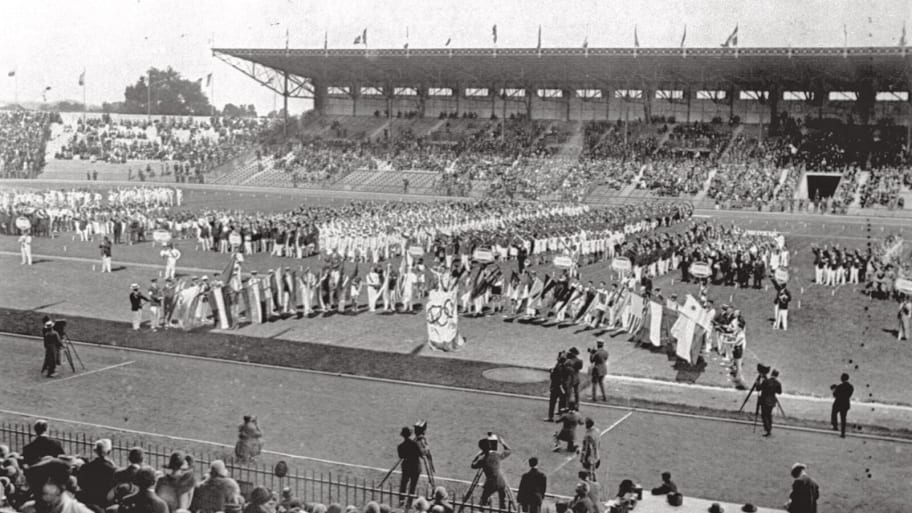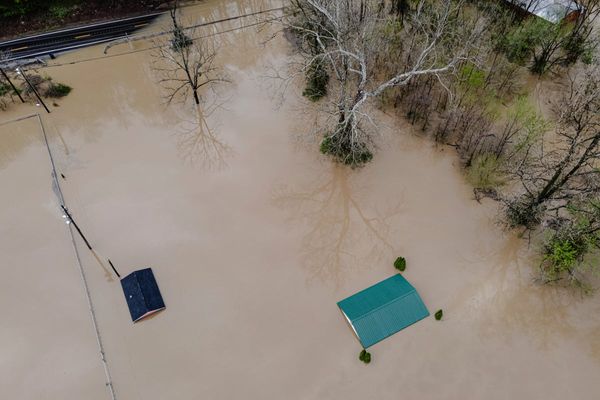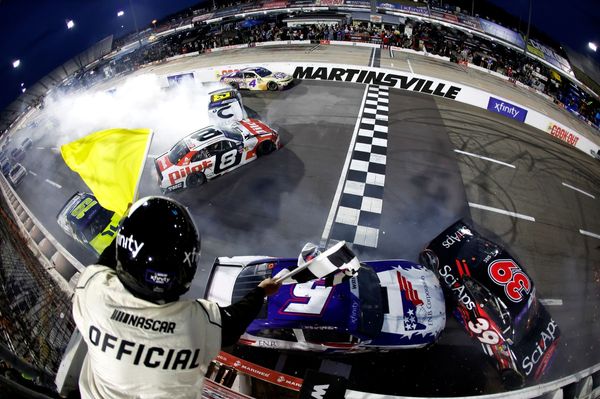
Check out Sports Illustrated’s Daily Rings, our daily Olympics podcast from Mitch Goldich and Dan Gartland. Subscribe wherever you get your podcasts (Apple, Spotify) and find clips on SI’s YouTube page.
It is the City of Light and the city of sights. No matter who’s judging the competition, it takes its place on the medal stand for the mythical title of World’s Most Visually Beautiful City. But this spring, Paris has been a city for the ears as much as for the eyes. Drowning out the accordions, the soundtrack is one of clanging, the hum of construction.
Yes, some of this audio comes from Notre-Dame, where renovations are happily—and uncharacteristically for the French—proceeding on schedule, repairing the damage caused by a 2019 fire to the world’s most famous cathedral. Most of Paris’s noise, though, emanates from the structures being jerry-built for the 2024 Summer Olympics.
On the lawns behind the Eiffel Tower, along the banks of the Seine, finishing touches are being applied to a temporary 13,000-seat structure that will host the beach volleyball competition. Not far away, on the other side of the river, bleachers are being installed at Place de la Concorde for the venue to host urban sports like BMX freestyle, skateboarding and (zut alors!) the first Olympic breakdancing (officially known as breaking) competition. In the suburbs of Seine-Saint-Denis, work is afoot on the Olympic Village for some 15,000 athletes, which will be used for low-income housing after the Games. About 10 miles outside of town in the other direction, the grounds at the Palace of Versailles are framed by bleachers to accommodate 40,000 fans for the equestrian events.
A year ago, you could’ve spent time in Paris and heard nary a bulldozer, scarcely realizing the next Olympics were coming to town. We are, after all, talking Paris. Not exactly the kind of place that needs 16 days of global sports to justify itself as a city of the world. If other hosts perceived the Games as a seminal moment in their city’s history, Paris seemed to be taking one for the team. The Olympic movement, that is. After the systematic Russian doping scandal in Sochi and cost overruns in Rio, the absence of fans (and one-year COVID-19 delay) in Tokyo, followed by a buzz-deprived Winter Games in authoritarian China, here was Paris to restore dignity and stability to the proceedings.
It was met with the famous Gallic pfft. The overall vibe was perhaps akin to Jimmy Kimmel hosting the Oscars: They need me more than I need the gig. But I’ll do it for the sake of the institution. Locals made vacation plans for late July and early August of 2024, listing their flats on Airbnb and predicting traffic and strikes and general chaos. Even politicians abandoned cheerleading to adopt a defensive posture: Let’s try to stay on budget and avoid a terror attack.
But this spring, in lockstep with the venue construction, Olympic enthusiasm undeniably ramped up. Large rings adorn Paris’s city hall. There are pop-up souvenir shops. Athletes—French ones, in particular—are featured on billboards and ads in the Métro. From hotels to nail salons, businesses are anticipating the premium prices they will charge. Paris 2024 chief Tony Estanguet (a three-time Olympic gold medalist in canoe slalom) is a media fixture, alternately lifting morale (“preparations are in good shape!”) and reassuring minds (the security apparatus will be “unprecedented”).
Paris, of course, has done this drill before. Twice actually. It hosted the second modern Olympics in 1900. Then, in 1924, the French capital again staged Games that were considered remarkable at the time, and, in retrospect, marked a hinge point in the Olympic movement. Pierre de Coubertin, father of the modern Games as the founder of the IOC, was also a proud Frenchman. And, in a benign prelude to sportswashing, he envisioned the 1924 Olympics as a way to show off Paris’s beauty and innovation while also projecting France’s robustness after World War I.
An even century ago, the Paris Games featured the first elaborate parade-of-nations opening ceremony, held at the main venue, the Stadium of Colombes, in the northwestern suburbs. There was a velodrome with stands designed by Gustave Eiffel (he of the eponymous tower), and the first athletes’ village, where most of the 3,000-plus competitors stayed for the duration, enjoying the free hairdresser and catered meals, before returning home on trains and steamers. Though Coubertin liked to declare the Olympics “a display of manly virtue,” these Games were open to 135 female athletes in three events (swimming, diving and tennis), a notable, progressive increase from previous Olympiads.

Assorted records were smashed in 1924, albeit in times that would not even make qualifying thresholds today. The heroes included “Flying Finn” Paavo Nurmi, who won gold in the 1,500 meters, and then, an hour later, in the 5,000. British runners Harold Abrahams and Eric Liddell, a Jew and a Protestant, won track golds, their unlikely feats memorialized in the film Chariots of Fire. Before becoming a Hollywood star portraying Tarzan, American swimmer Johnny Weissmuller won three golds in swimming and a bronze in water polo.
In a battle between nostalgia and practicality, there will be only modest overlap between Paris 1924 and Paris 2024. Both inside of France and outside to the IOC, one of the great selling points of the Paris bid was the abundance of preexisting venues, the few temporary structures being assembled now notwithstanding. (With so many stadiums and arenas already built, the Paris 2024 overall budget of roughly $10 billion is a fifth of what the Russians spent on Sochi.) But only a few are older than a century. The stadium in Colombes, which hosted everything from track to soccer in 1924, was renamed the Stade Yves-du-Manoir shortly after those Games and was recently renovated to host field hockey this summer. The Tourelle Pool, grandiose when it was inaugurated that summer a century ago as the first dedicated Olympic aquatic facility, will be used only as a practice pool. In addition to the athletes’ village, only two new, permanent venues were constructed for these Games—the Aquatics Centre in Saint-Denis and the Le Bourget Climbing Venue.
Organizers are also hopeful the Seine will play a much different role in 2024 than it did 100 years ago. Before the 1924 Games, there was talk of holding some swimming and rowing events in the serpentine river that wraps itself around the city. But in 1923, French authorities banned public swimming in the river due to its pollution. Even rowing was held at the Argenteuil Basin, located northwest of Paris on the banks of the Seine.
Like an athlete listed as day-to-day, the Seine’s status for 2024 remains uncertain. When Paris’s initial hosting bid was prepared, one of the big selling points for winning over the locals was that the Olympics would provide the catalyst—and funding—for cleaning up the river, even making it swimmable for the public during summer months. Roughly $1.5 billion has been invested in a filtration system, rainwater storage tanks and the extraction of bikes and scooters from the river bottom.
The opening ceremony would, for the first time in modern Olympic history, move out of a conventional stadium and be staged flotilla-style along the river. More than 600,000 fans—roughly the entire attendance of the 1924 Games, eight times the capacity of any Parisian stadium—would line the embankments for six kilometers to watch.
Those ambitions have been scaled back considerably. Owing to security concerns and expenses, the crowd of 600,000 for the opening ceremony has been pared down to 325,000—about 105,000 paid and 220,000 given free tickets via lottery. In the spring, there were talks of a Plan B, a literal course correction, whereby the ceremony ends up at the Trocadéro or in the main stadium, the Stade de France in Saint-Denis. (In fairness, the bid was prepared before the wars in Ukraine and Gaza.) What’s more, the contaminants that have tainted the river for more than a century have proven stubborn to remove.
With the Games fast approaching, French officials were feeling “very confident” after unveiling an underground reservoir near the city’s Gare d’Austerlitz station that can collect as much as 20 Olympic-size swimming pools’ worth of rain and wastewater, as a way of preventing sewage from overflowing into the river.
No matter La Seine’s status, Paris as host of this summer’s Olympics is likely to be music to the ears of many.
This article was originally published on www.si.com as In Paris, the Olympics Aim for a Return to Glory.







